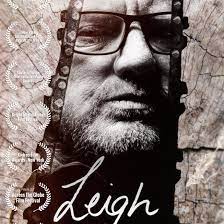
LEIGH
Australia, 2021, 100 minutes, Colour.
Leigh Conkie.
Directed by Ryan Gaskett.
“Portrait of the artist as a chainsaw sculptor”. And more, much more.
The sculptor is Leigh Conkie, from Elfin (if you put his name in Google, his address, 1305 Maine Road, Eltham immediately appears!). He is a Melbourne character and Melbourne features strongly in this documentary, in his suburb to Research and Diamond Creek, at a competition for chainsaw sculptors at the top of Mount Dandenong, city sequences outside the Age building, outside the courts in William Street. And, a self-conscious confession, this reviewer was not aware of Leigh Conkie.
We are treated to quite a number of stories within stories but the first aspect to note is the range of visuals of Conkie sculptures, and seeing him at work with his chainsaw, cutting off large blocks of wood but also fine-tuning, smoothing the detail of the human characters, the animals, monuments. It is a pleasure to look at these sculptures.
But, Leigh Conkie has had many difficulties in his life. In his 40s during the making of this film over three years, he is a rough and ready type, with an effing-spattered vocabulary, something of a contrast with the interviews with his many friends and neighbours, ready but much less rough. And, in his younger days, experience and depression, taking many drugs, and in later years becoming a drinker, he admits that he is not always reliable, drinking to get to sleep to forget the pressures of life. Nevertheless, he has persevered with his sculpting for several decades, surprised at first at being paid well for his sculptures, but always wanting to sculpt for the sake of his art.
While he is a big tall man, he actually can be quite soft-hearted. There is an admirable section of this film where he speaks so well of his father, with affection, and especially so of his mother. And plenty of photos of his parents with himself and his brothers. Quite wonderful to hear this man speaking so warmly of family. On the other hand, what is revealed is that he was abused at school at the age of seven by the school principal. This becomes a major theme of the film.
Conkie eventually has some strong things to say about sexual abuse, paedophiles, recounting some of the blurred memories of his experiences, with a photo of the alleged abuser up there on the screen, later named quite explicitly. Eventually, he does go to the police, an awkward experience but one that he feels it is necessary, eventually charges being laid against the abuser, now in his 80s. There is reinforcement of this theme of sexual abuse with substantial interviews with radio campaigner, later politician, Derryn Hinch. Hinch is rather calm, seated for these interviews, but reminiscing about the stances by abusers, the use of defence lawyers, the reduction of charges, and the effect of court cases on the survivors. It is a reminder of Hinch’s stances over many decades.
Eventually, some other survivors come forward and the perpetrator is found guilty, sentenced to prison. Sadly, because of his drug past, the defence lawyers are able to get Conkie’s testimony dismissed as unreliable.
In between these episodes concerning the abuse, audiences are surprised that they have a tour to Japan, to climbing Mount Fuji, Conkie deciding that this is a good purpose, going off the drink, going on a health diet, walking, gym exercises… The sad thing is that for many years he has been plagued by gout, in his knees, but, especially some excruciating gout pain in one of his thumbs. He makes a worthy attempt to climb to the peak of the mountain, while enjoying Japan itself and the people.
And one other theme. He is compassionate towards refugees, those on Manus Island in Nauru, deciding to sculpt a statue of a refugee (and we watch this in some detail), with the plan to situate it, in the early morning hours, on the grounds in front of the Age building, across from Southern Cross station. The director has his cameras watching this episode as well as people passing by, generally not noticing, and the removal of the statue. A positive ending to this story is that it was granted to the Asylum Seeker Resource Centre where Conkie visits it.
And, all of this, with sympathy and visual flair for 100 minutes. And postscript: go to the link, https://www.3aw.com.au/photos-chainsaw-artist-honours-war-heroes/with photos of more recent, striking sculptures honouring war heroes.